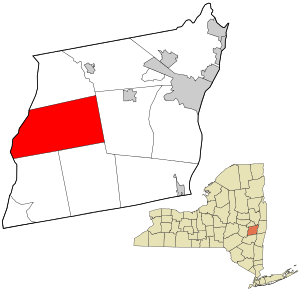Berne, New York
| Berne | |
|---|---|
| Town | |
| Motto: The center of the Helderbergs, "It's all down hill from here" | |
 Location in Albany County and the state of New York. |
|
| Coordinates: 42°35′50″N 74°7′25″W / 42.59722°N 74.12361°W | |
| Country | United States |
| State | New York |
| County | Albany |
| Government | |
| • Type | Town Council |
| • Town Supervisor | Kevin Crosier (D) |
| • Town Council |
Members' List
|
| Area | |
| • Total | 64.8 sq mi (167.7 km2) |
| • Land | 64.1 sq mi (166.1 km2) |
| • Water | 0.6 sq mi (1.6 km2) |
| Elevation | 1,345 ft (410 m) |
| Population (2010) | |
| • Total | 2,794 |
| • Density | 43.6/sq mi (17.1/km2) |
| Time zone | Eastern (EST) (UTC-5) |
| • Summer (DST) | EDT (UTC-4) |
| ZIP code | 12023 |
| Area code(s) | 518 |
| FIPS code | 36-06211 |
| GNIS feature ID | 0978728 |
Berne is a town in Albany County, New York, United States. The population was 2,794 at the 2010 census. The town is at the west border of Albany County.
The town of Berne (originally spelled "Bern" until the Berne Post Office was established in the middle of the 19th Century) was created in 1795 from part of the town of Rensselaerville. In 1822 the north half of Berne was spun off to form the new town of Knox.
The earliest settlers were Palatine German refugees. Settlement began before 1750. At that time it was called Beaver Dam (also spelled Beaverdam). The settlers were actually squatters, since in the 18th and most of the 19th centuries, Berne was part of the Rensselaerswyck estate. The head of the Van Rensselaer family was the patroon who owned all the land on which the tenants in the Hudson Valley lived, and used feudal leases to maintain control of the region. Before the Revolutionary War, the patroons acted as feudal lords, with the right to make laws.
The massacre of the Dietz family in 1781 was the only Iroquois incursion in Beaver Dam during the American Revolution. During the War inhabitants fought on both sides of the conflict. Loyalists who supported the British left and went to Canada. Those who stayed and fought the British expected that if they won, they would either be released from their tenancy, or at the least, be allowed to purchase the land at fair market value. Instead, the new government of New York decided to honor the lease contracts of the patroons, who contributed heavily to the politicians.
The first mass meeting of tenant farmers leading to the Anti-Rent War was held in Berne on July 4, 1839. In January, 1845 one hundred and fifty delegates from eleven counties assembled in St. Paul's Lutheran Church to call for political action to redress their grievances.
...
Wikipedia
